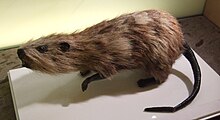Island gigantism

Island gigantism is a biological phenomenon in which the body size of animal species or the size of individuals, seeds or flowers of plant species that live on an island increases significantly over generations. This can be observed in island populations of a subspecies, but also in subspecies and species endemic to islands . Island gigantism is often triggered by the absence of predators, which negates the evolutionary advantage of a small, more easily hidden body. An opposite phenomenon is the so-called island dwarfing .
Regarding the size change in mammals, a so-called island rule is described, according to which large species become smaller, while small species become larger. As a rule of thumb, a striving for a mass of 1 kg on islands is postulated, which on average should represent the most biologically effective measure for the average mammal construction plan, but deviates in individual families.
Examples of island gigantism in plants are also quite common; a well-known example are the extremely large fruits of the Seychelles palm . Other examples are Deinogalerix (giant hedgehog on Gargano Island that died out 10 million years ago ), giant rats on Flores Island (Indonesia) and giant hatias in the Caribbean.
Individual evidence
- ^ A b Robert J. Whittaker, José María Fernández-Palacios: Island Biogeography: Ecology, Evolution, and Conservation . Oxford University Press 2007, ISBN 978-0-19-856611-3 , p. 186.
- ^ David Ross Stoddart : Biogeography and Ecology of the Seychelles Islands , Springer Netherlands 1984, ISBN 90-6193-107-X , p. 206.
